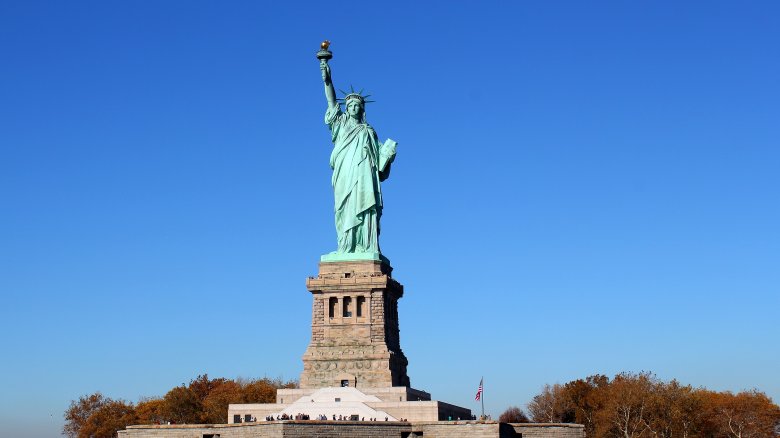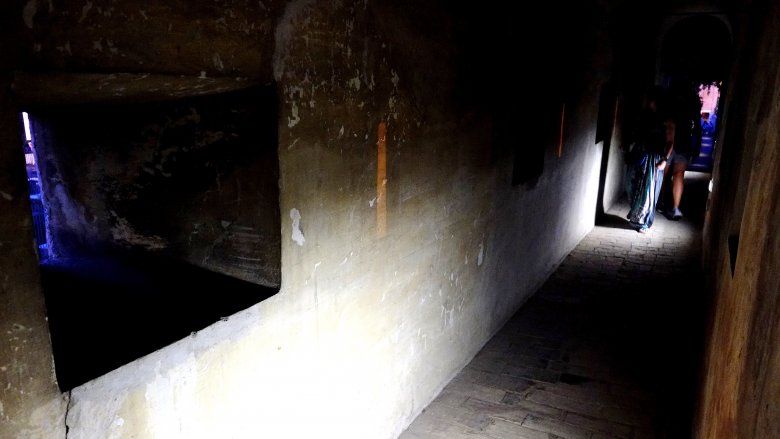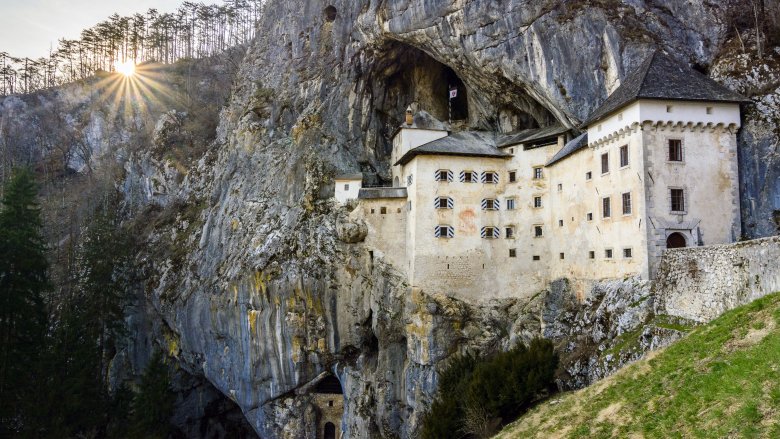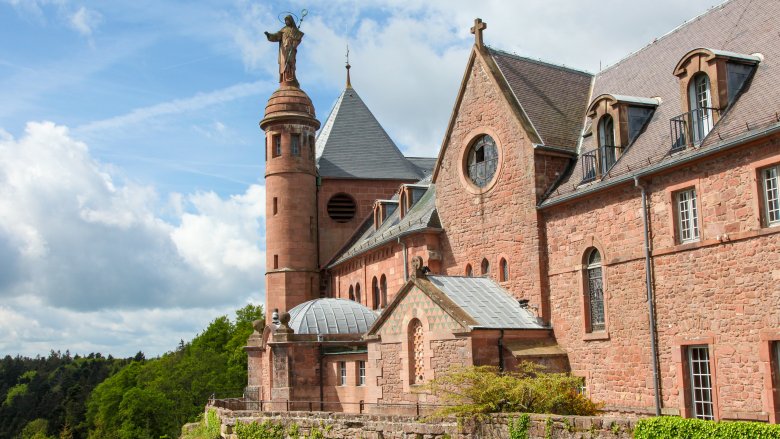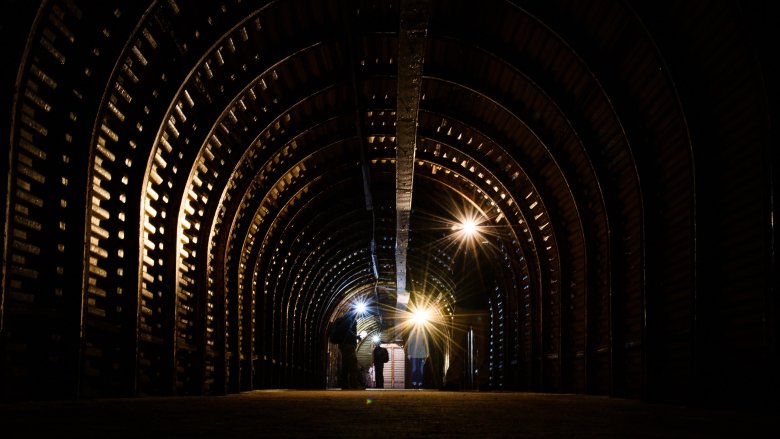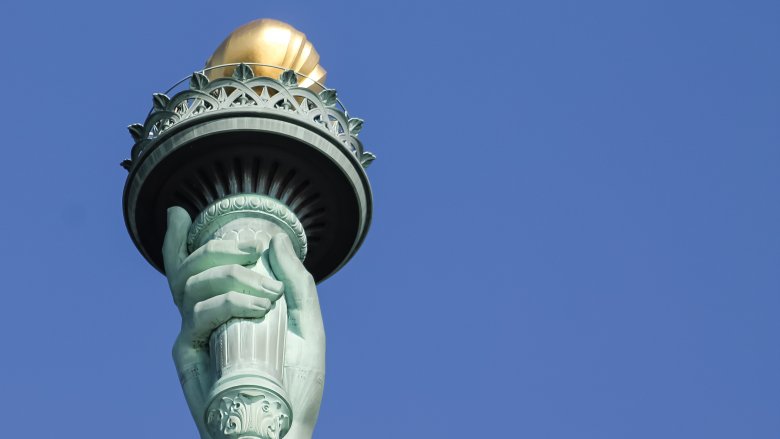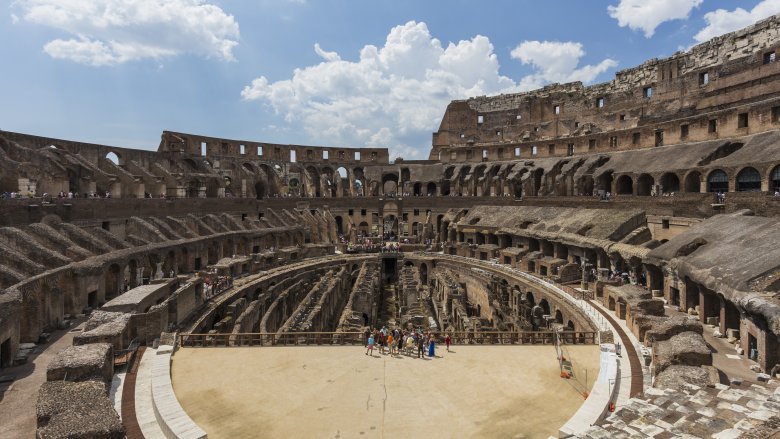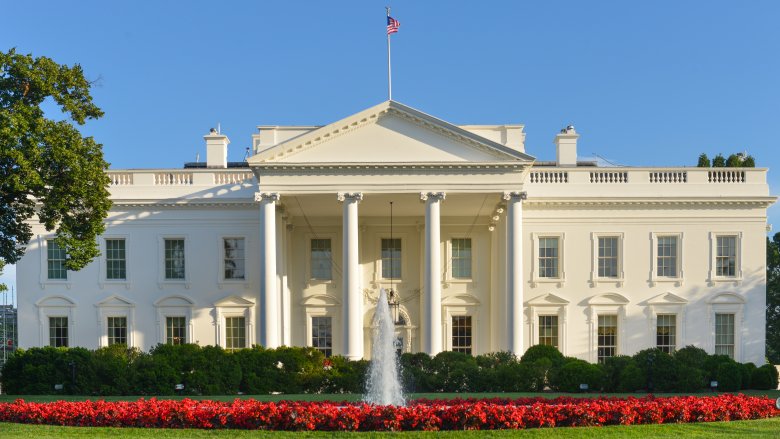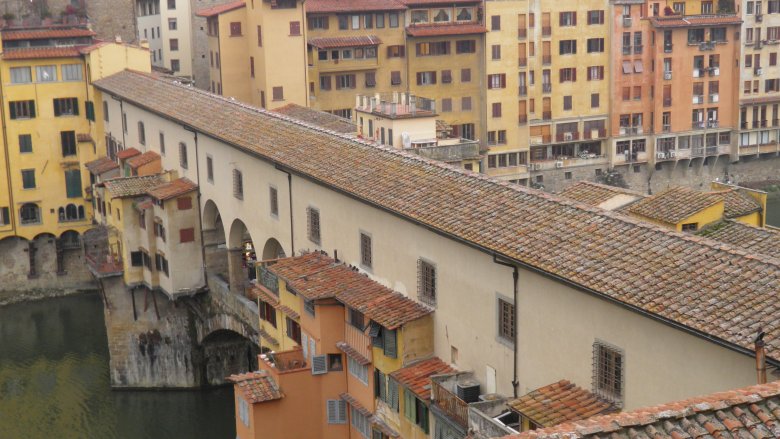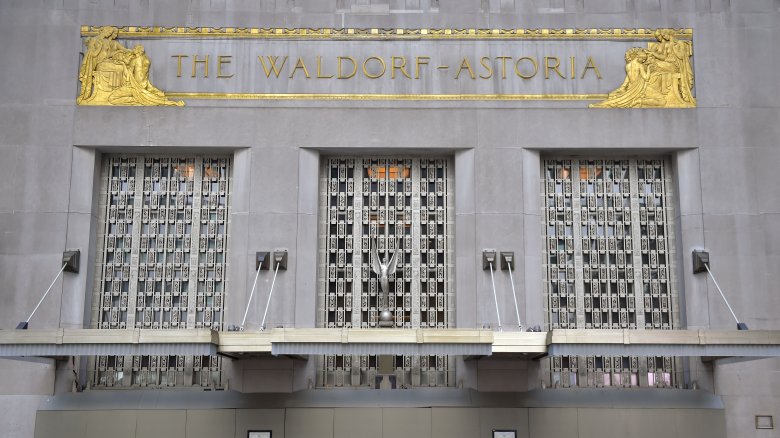Secret Passages You'll Find In Famous Landmarks
There's nothing people want to discover more when they move into a new house than a secret passage. Secret rooms are cool, too, but a passage has so much more potential — it can lead anywhere. And while you might be desperately pulling books out of your bookshelf, looking for the one that makes it swing out, some people have been finding them in much more interesting locations. Some of the most famous buildings in the world have secret passages and tunnels built in. The best part is that you can check out some of the not-so-secret ones yourself.
Popes used a secret passage to escape their enemies
With our nice current pope who goes about his business being head of the Catholic church all quietly with minimal drama, it's easy to forget that the pope used to be in charge of a country. Sure, it was a small country, but it was still his and that meant sometimes other people wanted to come along and take it. And if you captured the pope, even better; you suddenly had one of the most powerful men in the world as your prisoner.
So obviously the pope wasn't too keen on being caught. And while the Swiss Guards are complete badasses, even they weren't enough to protect His Holiness sometimes. According to Slate, that's where the Passetto di Borgo came in. Built to look like a regular old fortification, it was actually a secret tunnel stretching Vatican City to the Castel Sant'Angelo.
It was started in 850 A.D., but they took their sweet time on it. It wasn't finished until 1492. Just two years later it was used for the first time, to get Alexander VI away from the French. In 1527 it was put to use again, when Clement VII ran away from 20,000 of the Holy Roman Emperor's troops. After that it fell into disrepair, but was fixed up again in 2000 since Christianity was celebrating a special birthday and wanted everything to look nice. These days it's probably used more for fleeing pushy tourists than fleeing armies.
There are lots of tunnels under the U.S. Capitol
Capitol Hill isn't just home to the famous domed building. It also has lots of smaller buildings that house boring stuff like offices. But the weather in Washington, D.C., can be terrible for a lot of the year, and politicians decided a long time ago they were too important to have to struggle through snow and rain. That's why there are tunnels connecting the various buildings underground.
Originally built in 1909, according to Greater Greater Washington, these tunnels were helpful, but they were also long and politicians aren't exactly known for being in shape. (Except you, Paul Ryan.) That's why almost as soon as they were built people started wondering how they could get around them faster. In the end they went for electric cars. Strangely, the tunnels were never given a speed limit. Eventually the Studebakers gave way to a monorail, which could fit 12 Senators or, by some clown car magic, 36 congressional pages. There was also still a separate walkway for anyone who actually wanted to get some exercise during their work day.
But Atlas Obscura says the most secret tunnel under the Capitol is a quarter mile long and took two years to build, starting in 2003. Its exact location has never been disclosed, although some people think they've figured it out using Google Earth. And what is this most secret of tunnels used for? Taking out the trash. Literally. It's there for more effective trash collection, and that's basically it.
Predjama Castle is connected to caves by a secret tunnel
Some castles are built to be pretty, massive houses for royalty to enjoy themselves in. Predjama Castle in Slovenia is not one of those. It was built over the course of 400 years to be absolutely impregnable. Living there was to say to opposing armies,"Yeah, just come and try it." And according to Lonely Planet, it (mostly) worked.
Predjama holds lots of secrets, like a 16th-century chest of treasure that wasn't discovered until 1991. But the most interesting is its secret passage connecting it to a network of caves. This wasn't so the occupants could hide their shameful love of spelunking from the servants. It was there in case a siege lasted too long and folks needed to get out — and it came in useful at least once.
In the 1400s, a Slovenian version of Robin Hood named Erazem Lueger occupied Predjama. But his country was at war with Austria, and his enemies tried to take the castle. Since it was built halfway up a cliff, they had no choice but to try to starve Lueger out. Thanks to the secret passage, it didn't work. Lueger was able to sneak out and get all the food he needed. He even started throwing fresh cherries at the army to show them how sweet he had it inside. According to legend, Austria did the reasonable thing and blasted him off the toilet with a cannonball.
A guy used Mont Sainte-Odile's secret passage to steal priceless books
Mont Sainte-Odile is a monastery sitting atop a mountain in France that dates from the 600s. When you've been around that long, it isn't shocking that people might forget about the existence of a secret passage. But if the monks there in 2000 had looked at an old floor plan of the place it might have saved them two years of pulling their hair out.
According to the Telegraph, suddenly one day, books started disappearing from the monastery's library. And we're not talking stuff you can pick up on Amazon. These were ancient tomes, like illuminated manuscripts and other books from before the printing press was even invented. So the monks changed the locks. When stuff kept disappearing, they posted guards and changed the locks two more times. Finally, after two years, they discovered what was happening: a local teacher had found a forgotten passage from a hotel that used to be part of the abbey to a secret panel in the library and had been carrying off whatever he wanted.
Atlas Obscura reported that the thief only took books he felt had been "abandoned," ones that were covered in dust and pigeon poop. While all that means is the monastery needed a better cleaning service, the burglar thought the books would never be consulted again. Perhaps he thought their vow of chastity prevented them from loving the books like he could. In the end he managed to take more than 1,000 and stored them neatly in his apartment.
Dover Castle has secret wartime tunnels
If you go to the southeast corner of England to check out Dover's ancient castle and stand on its famous white cliffs, you could actually be standing on a labyrinth of secret tunnels without knowing it. According to English Heritage, some of the tunnels were originally built as barracks to house soldiers during the Napoleonic Wars in the early 1800s, but it was during World War II that the tunnels really came into their own.
From 1939 on, they housed a command center where the people in charge directed naval operations in the English Channel. They even organized the evacuation of Dunkirk from underground. The tunnels were secretly expanded until they had room for both the headquarters and a hospital.
They built so many new tunnels that some of them are still being discovered. The Guardian says the National Trust discovered hundreds of feet worth of tunnels in 2012 and opened them to the public three years later. Of course, since there were mostly soldiers down there, there's some fabulous graffiti. The former bathrooms are especially rich in deep wartime thoughts like, "If you come into this hall, use the paper not this wall. If no paper can be found, then run your arse along the ground." Facing your own mortality would turn anyone into a poet.
The Statue of Liberty has a passage to its torch
If you've ever visited New York City, you probably hopped on a boat out to Liberty Island to climb up the dress of the big lady standing there. If you haven't been, put it on your bucket list because the view from the Statue of Liberty's crown is worth the trip. But why does everyone have to stop at the crown? If you look closely at the torch you can see it even has a convenient railing to lean on. Well, it's theoretically possible, but unless you're really special you can't go up there.
There's a secret passage up to the torch. National Geographic reveals that the upraised arm of the Statue of Liberty houses a 40-foot ladder that you could climb up, and people used to do it, until wartime ruined it all.
AM New York has the story. In 1916, America wasn't involved in World War I yet, but it was giving assistance to France and Britain by selling them munitions. This really pissed off the Germans, and they sent some spies to do a bit of sabotage. When they blew up a pier, they killed a few people, injured hundreds more, and managed to pelt the Statue of Liberty with debris. It damaged the arm and torch so badly they had to be closed.
Despite the damage finally being repaired in 1984, the passage was never reopened, and the crown is still the highest you can go.
The Colosseum sits on dozens of tunnels and passageways
The Colosseum in Rome was the biggest amphitheater ever built by the Romans. It could seat 50,000 people and housed epic battles involving humans, animals, and even ships sometimes. But until 2010, the 20,000 daily visitors were only allowed to check out what went on above ground. What they wouldn't have known is the Colosseum sits on top of a complex network of tunnels and passageways, which made what was happening up top possible.
The Telegraph compares it to being backstage at a Broadway show. The tunnels housed the animals and gladiators that were waiting to go out and kick some butt. The animals would wait there until they were forced into cages and winched up through trap doors into the arena. Gladiators would try to stay calm while waiting for their turn to fight, hearing the cheers of the tens of thousands of spectators coming through the roof. It wasn't the best place to have to contemplate your mortality, either. The tunnels were narrow and cramped, the smell from the various animals and scared humans was terrible, and it was hot thanks to everything having to be lit by candles.
But the conditions underneath made it nice for the people up top. There was even enough room down there for a complex system of sewers. This meant that the Colosseum could be fitted with toilets and water fountains, so people could watch a nice bit of death without that pressing bathroom feeling.
There's a secret entrance to the White House
Unless you know where it is (on H Street), you'd probably miss the secret tunnel that leads into the White House. The only things that give it away are the crash-proof barrier blocking it, a discreet Secret Service booth, and, oh, a sign telling everyone to back off. Other than that, it looks like a normal alleyway. It was originally built in 1919 to stop Treasury employees from getting robbed when they were walking around with a bunch of cash on them. But in the 1940s, everyone's thoughts turned to the safety of the president and the tunnel was expanded.
It now leads to the basement of the White House. According to Atlas Obscura, the idea was if Washington was bombed, Franklin Roosevelt could be wheeled along the tunnel to the treasury building where a vault had been built as a cozy bomb shelter. They tried, anyway, adding carpet and furniture so the president would be comfortable, but after looking at it once, FDR decided he hated the "tomb-like" room and never went back.
The White House Historical Association says these days, the tunnel and room still exist and in theory might still be put to use. Until about the end of the Cold War, presidents spent part of their busy first day in office inspecting the bomb shelter, so they would know where they were going to end up if everything went wrong, a nice stark welcome to becoming the most powerful person in the world.
There's a secret passage full of art in Florence
Plenty of people head for Italy to check out the art scene. While finding out how cold it was in the room when Michelangelo was sculpting David is all well and good, one art gallery in Florence is more on the secret side. The general public isn't allowed in, and if you want to see its collection you need to set up a private group tour.
That's because this gallery is actually in a secret passage. It's called the Vasari Corridor and it connects the Palazzo Vecchio to the Palazzo Pitti. According to the Uffizi Gallery Museum, it was built in just six months in 1564. The idea was that the ruling family at the time, the Medicis, and anyone else they thought was important enough, could walk from the seat of power to their main house without having to mix with the riffraff on the streets. But it wasn't enough just to be off the dirty roads — they even wanted it to smell nice in their secret passage, so they made sure the traditional butcher shops that sent gross dead meat scents up to the corridor were removed and replaced with jewelry shops.
The rich people also wanted something nice to look at while they strolled from one palace to the next, so they added a collection of their own self-portraits. Soon word got out and artists began giving them more to display in their private gallery. These days it houses more than 1,000 works of art.
The Waldorf-Astoria sits on top of an old subway tunnel
Here's something that hasn't changed since the first human had a shiny thing and another human had none. Rich people still try to avoid the hoi polloi as much as possible, and in the mid-1900s the famous Waldorf Astoria hotel in New York City gave them that option. According to Gothamist, starting in 1929, they leased the railway underneath their hotel and turned it into a private train station for important people to be able to go directly from their private train car, up a private elevator, and into the exclusive hotel without ever having the chance of being accosted by one of those poor people who were suddenly everywhere thanks to the Great Depression.
People like legendary General John J. Pershing used the secret entrance, as did President Franklin Roosevelt, who seemed to have a thing for these kinds of secret tunnels. FDR used the entrance in part to hide his disability from the common people. The last VIP to get use out of the tunnel was most likely artist Andy Warhol who decided the dusty old place was the perfect spot to throw a (probably pretty illegal) party in 1965.
At least as recently as 2011, the track, an old train car, and the elevator were still there with no plans for removal. People aren't allowed down there now, but you can catch a glimpse of the forgotten tunnel if you're fast. If you look right through the windows as you leave on a MetroNorth train you get a quick look at it. That's enough for you, plebeian!
